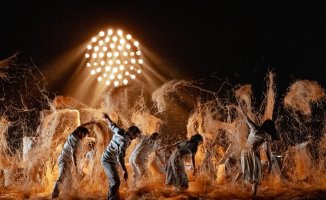On Wednesday, October 31, 1973, a unique match was played at Camp Nou. Organized by FIFA and dubbed the First World Day of Football, it pitted the teams of Europe and America against each other, two teams of stars who offered a spectacle of open play and goals. The president of FIFA, the Englishman Sir Stanley Rous, assumed the direction of the organizing committee and for a couple of days he wanted to explain that Barcelona was the world center of football, but in reality, in addition to the presence of some cracking of the ball, everything was reduced to a couple of conferences and the exhibition, at the Palau Blaugrana, of the stamp collection of the then president of the Diputació de Barcelona, Juan Antonio Samaranch.
Rous felt that a charity match with big stars in action could be the best vehicle to display spectacular football, away, he said, from "the violence of the killers" (assassins) that was spreading. It didn't help much, as could be seen just a few months later, in the legendary European Cup clash between Glasgow Celtic and Atlético de Madrid. And still in 1977, in the historic match between Yugoslavia and Spain, with Argentina's World Cup qualification at stake, played at the Little Maracanã in Belgrade.
Barcelona's festive match was played in an atmosphere of footballing euphoria in the city, just three days after Cruyff's debut, and was widely promoted in the press. Television images reached half the world via Eurovision and the OTI, locations were offered at very affordable prices and the names of the selected stars were widely publicized, although then came the inevitable and very outstanding last-minute layoffs. Perhaps for this reason, public attendance was low and the bleak image of a much more than half-empty Camp Nou (around 15,000 spectators) also went around the world.
Finally, the European starting eleven, with Kubala on the bench, was little more than a mixture of footballers from the Spanish League, some elements of fame and players today quite forgotten. Viktor (Czechoslovakia), Krivokuca (Yugoslavia), Sol (Valencia), Fachetti (Italy), Asensi (Barcelona), Pavlovic (Yugoslavia), Bene (Hungary), Keita (Valencia), Cruyff (Barcelona), Eusebio (Portugal) and Jara (Valencia). Then entered Iríbar, Pirri, the Swede Edström, the Swiss Odermatt, the Portuguese Nené and the Greeks Kapsi and Dimitriu. With the players announced and never seen, a much more attractive block would have been formed. Madrid and Atlético, who faced each other the following Saturday, alleged inconvenience for not selling Netzer and Ayala. And also missing promoted stars were Jennings, Bobby Moore, Beckenbauer, Müller, Krol, Gigi Riva, Neeskens, Hulshoff...
The American team was led by Argentinian Enrique Omar Sívori (Brazilian Mário Zagallo was also supposed to appear, but did not come). The Argentines Santoro, Wolf and Brindisi, the Brazilians Pereira, Marco Antonio, Paulo César and Rivelino, the Uruguayan Espárrago and the Peruvians Cubillas, Chumpitaz and Sotil lined up. Then entered Carnevalli, Caszely, Arrúa, Fernando Morena, the Mexican Enrique Borja, the Colombian Willington Ortiz and the Ecuadorian Félix Lasso.
Where there were no last-minute casualties was in the Camp Nou box office, this one with the complete poster. The leaders of world football were able to enjoy a spectacular match, with carefree attacking play and outstanding individual actions. It ended with a four-goal tie. They scored Sotil (0-1), Eusebio (1-1), Keita (2-1), Cubillas (2-2), Asensi (3-2), Jara (4-2), Brindisi (4-3) and Chumpitaz, penalty kick (4-4).
To determine who would keep the trophy, the work of the Barcelona jeweler Puig Doria, penalties were thrown, in which the Americans prevailed by 2-3. It was announced that the second edition would be in 1974, in Lima. But there was no other world football day.













